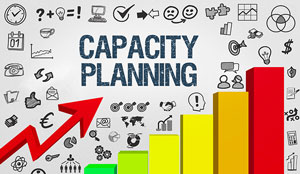Managing the ongoing challenge of workforce capacity planning in an ever-changing contact centre environment isn’t for the faint-hearted. However, there are strategies and techniques every manager can apply to help ensure success.
Here, some of our readers share their hints and tips for achieving the best outcome.
Buy-In From the Team Is Just as Important as Getting the Numbers Right
It takes confidence and honesty to deliver capacity-planning strategies that your team trust and believe in. Here are some tips on maintaining a trustworthy reputation and getting buy-in from your team – time after time.
1. Don’t Change Your Forecast to Meet Targets
When capacity planning, it’s critical to be (and be seen as) a keeper of truth. It helps to get into good habits here. For example, admitting your errors and accounting for them.
Try to avoid changing history to justify anomalies, or changing your forecast to meet targets. Not only do you risk your professional reputation in getting caught out, but you could miss valuable opportunities to learn and improve moving forward.
With thanks to Ruth
2. Avoid Spreadsheets When Presenting Plans

With so many numbers and influencing factors in play, it’s very easy to get bogged down in the detail.
This can confuse everyone and risk sending mixed messages to the team.
Instead, be clear about what you are trying to achieve and avoid spreadsheets when presenting your plans.
It can also help if you take the time to explain things, answer any questions, use visual aids to outline your plans, and share additional information with your team after any meetings.
With thanks to Andy
3. Lead With Facts and Confidence
There’s no room for guesswork when it comes to capacity planning best practices.
Always base your decisions on the information in front of you. It also helps if you share some of these reasonings with your team – being careful not to overcomplicate things – so they understand the “why” and not just the “how”.
This will help you to state your intentions with confidence and achieve better buy-in in the long run.
With thanks to Joshua
4. Make Everyone Look Great
When things go well and a strategy works, always be sure to share the success with the team – and not just claim a quiet, personal victory.
It’s a win–win to emphasize the team effort in delivering the strategy.
With thanks to Eleanor
5. Listen to What Your Agents Are Saying
Often, your agents will be a good source of information about what’s really happening on the contact centre floor. They can also have good ideas for making positive changes.
It’s therefore important to be friendly and approachable (try to lose the policing attitude), as well as offering structured opportunities for regular feedback on the good, the bad and the ugly. Over time, your agents will feel more empowered, and sharing ideas and insight will become the cultural norm. Your capacity planning will be much better for it!
With thanks to Sophie
Change HOW Your Agents Work
Shift patterns and working practices can be deeply embedded in a contact centre’s culture. This can result in managers doing things the way they’ve always been done – and missing valuable opportunities to improve. Could your agents benefit from you thinking “outside the box”?
Read our article Contact Centre Shift Patterns: The Latest Findings taken from our 2021 Survey to see what contact centres are doing currently.
6. Challenge Your Scheduling Beliefs
Remember, change starts with you!
If you dare to challenge your own beliefs about scheduling and champion doing things differently, you can begin to influence your team too and make changes for the better.
With thanks to Edward
7. Open Up Your Holiday Schedule in Advance So You Can Plan for Bottlenecks
Have you tried opening up your holiday schedule as far in advance as possible? This can help you to see and plan for bottlenecks of resource in advance.
It can also help remove the issue of agent demotivation when their short-notice holiday requests are denied due to capacity issues.
With thanks to Garry
8. Treat Everyone Equally When It Comes to Scheduling
Some contact centres have working practices in place that give preference to those who are longest serving or high performers.
However, this can foster resentment, as well as result in preferred shift patterns being denied to those that need them most. This can even result in high levels of churn if shifts regularly don’t align with agents’ lifestyle needs.
Instead, managers should focus on fairness and finding options that work best for everyone in their team – even if they’ve only just joined.
With thanks to Jenny
9. Group People Together Based on Lifestyle and Rotation Preference
Don’t forget that people have different lifestyles. What’s right for one person isn’t right for someone else – but you won’t find out unless you ask!
What’s right for one person isn’t right for someone else – but you won’t find out unless you ask!
Talk to your teams and group people together based on lifestyle and rotation preference. You may find you have more volunteers for the late shifts – and even night shifts – than you bargained on.
With thanks to Garry
10. Highlight Wasted Time and Weaknesses in the Current Planning Process
When trying to build a case for positive change, it can help to highlight where time is being wasted in managing the current process.
For example, if you are wanting to move to preference-based scheduling, why not investigate exactly how much time the planners are wasting doing shift-swaps and trying to accommodate agents moving shifts.
With thanks to Aaron
11. If In Doubt… Get Your Union Rep Involved
When faced with a deeply rooted working culture, why not speak to your union representative to help build a case as to why it’s time for some positive change?
You can then factor in travel times to work, shift preferences, lifestyle and other factors to highlight that a change to shift patterns (for example) is the fairest way forward.
With thanks to Mary
For more suggestions on how to schedule contact centre staff, read our article: The Best Ways to Schedule Contact Centre Agents
Getting It Right “Behind the Scenes”
There’s a lot to consider in capacity planning, but a focused strategy can make all the difference. Here are some tips on areas to home in on to help you block out the noise and deliver the best possible outcomes.
12. Make the Best of the Tools You Have
So many capacity-planning tools are underutilized.
Ask yourself, are you getting the most out of your workforce management system? What or who could help you maximize its potential? Could your “scheduling toolkit” and methods do with a refresh?
By constantly challenging HOW you use the tools at your disposal, you can be sure you are always doing your best for your team.
13. Set Some Goals
There are so many factors at play that impact capacity planning. Therefore, it can really help focus your strategy by deciding exactly where the problem areas are and what you are trying to achieve.
For example:
- Cost reduction
- Improving efficiency
- Unleashing trapped labour
- Increasing staff or customer retention
- Increasing sales
- Understanding (and avoiding) missed sales opportunities
Once you’ve set your goals, keep an eye on your metrics too! It can also help to share these goals with your teams, so they understand the reasoning behind the changes and what’s being achieved.
14. Define Your Shrinkage Really Clearly
Define your shrinkage at a granular level and don’t forget to include things like operational feedback and off-the-phone time for performance improvement.
With thanks to Owen
15. Factor in Speed-to-Competency Calculations
Include speed-to-competency calculations in your forecast based on new and/or returning people to the roles, as they won’t be 100% efficient from day 1. Factor this in and manage your expectations accordingly to avoid disappointment and unnecessary anomalies in your data analysis.
With thanks to Dave
16. Give Your Team Leaders Visibility
Maximize your workforce management system by allowing team leaders visibility of the intraday view schedule in 15-minute or 30-minute increments. This will help get them involved in the process.
With thanks to Garry
17. Find Out Which Departments Impact Your AHT and Service Levels
Do you have visibility across the business?
By looking at all areas across the business and other internal service levels, you can start to see (and plan for) how these can impact your AHT or service level.
With thanks to Sophie
Don’t Rest on Your Laurels
The biggest mistake you can make with capacity planning is to do things the way they’ve always been done. Here are some tips to help drive a culture and personal mindset of continuous improvement.
18. Allow for Variety to Keep Refreshing Everyone’s Skills
Allow agents to work across all channels on a rota – instead of offering additional channels (e.g. chats and emails) to those who are the quickest. This will help to keep everyone trained up and allow for more flexibility with managing capacity. Also, those out of practice or retraining can eat into your productivity and the flexibility of your workforce.
With thanks to Jackie
19. Run Regular Employee Surveys – and Take the Feedback Seriously

Take the feedback you get on employee surveys seriously.
Take the feedback you get on employee surveys seriously.
Always acknowledge it and be transparent with all employees about what’s been said and what’s been done. A regular “you said, we did” update can really boost engagement with the process.
With thanks to Jackie
20. Review, Review, Review
Don’t rest on your laurels.
What worked yesterday may not work tomorrow, so don’t just keep on doing the same thing month on month.
With thanks to Aaron
To find out more about planning in your contact centre, read our articles:
- Workforce Planning: 20 Fundamental Rules
- 20 Demand Planning Techniques for Your Call Centre
- 17 Resource Planning Tools and Techniques You Should Know
- Workforce Management Reference Guide
Author: Robyn Coppell
Published On: 21st Feb 2022 - Last modified: 23rd Jul 2024
Read more about - Hints and Tips, Capacity, Editor's Picks, Forecasting, Staffing, Team Management, Workforce Management (WFM)
















